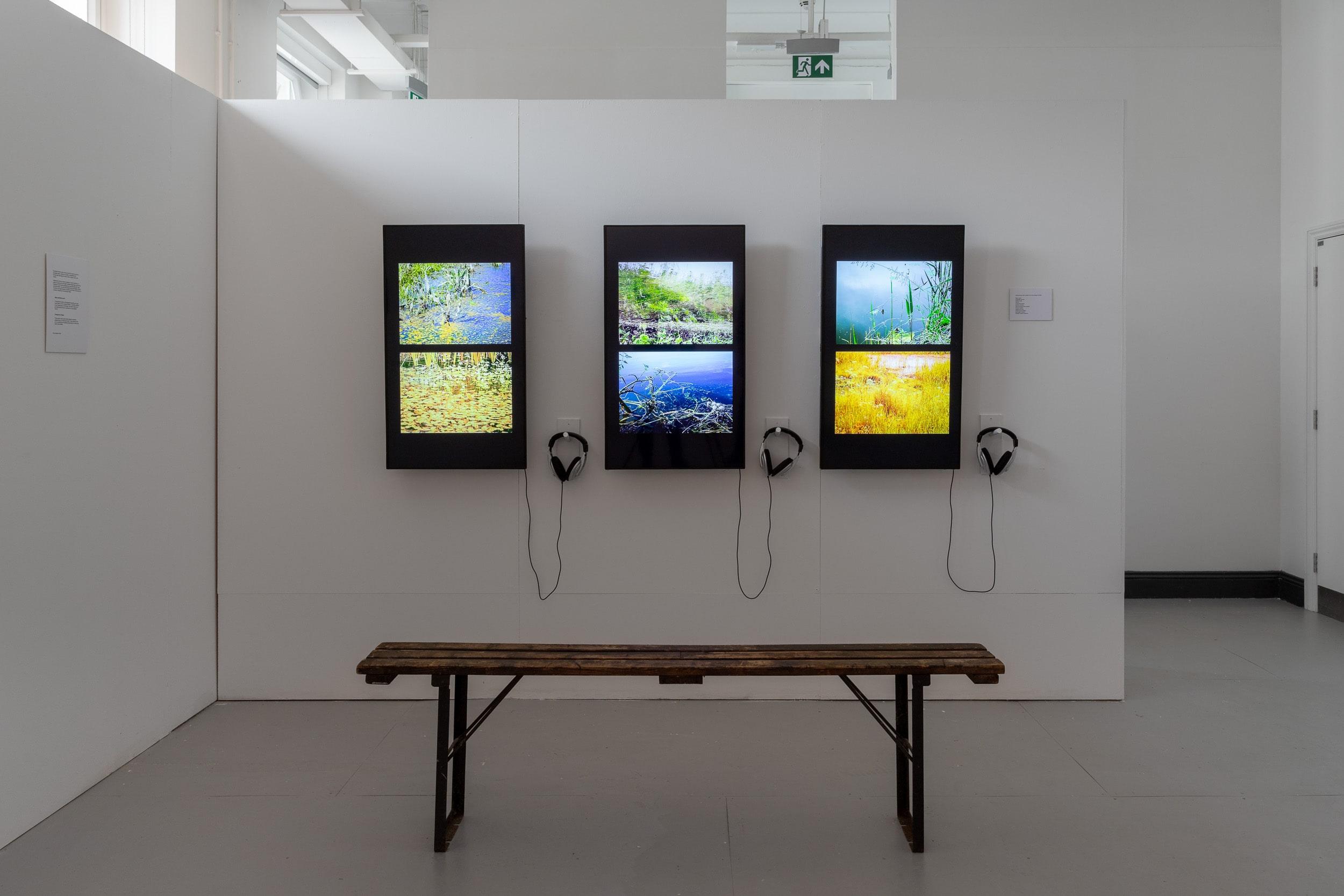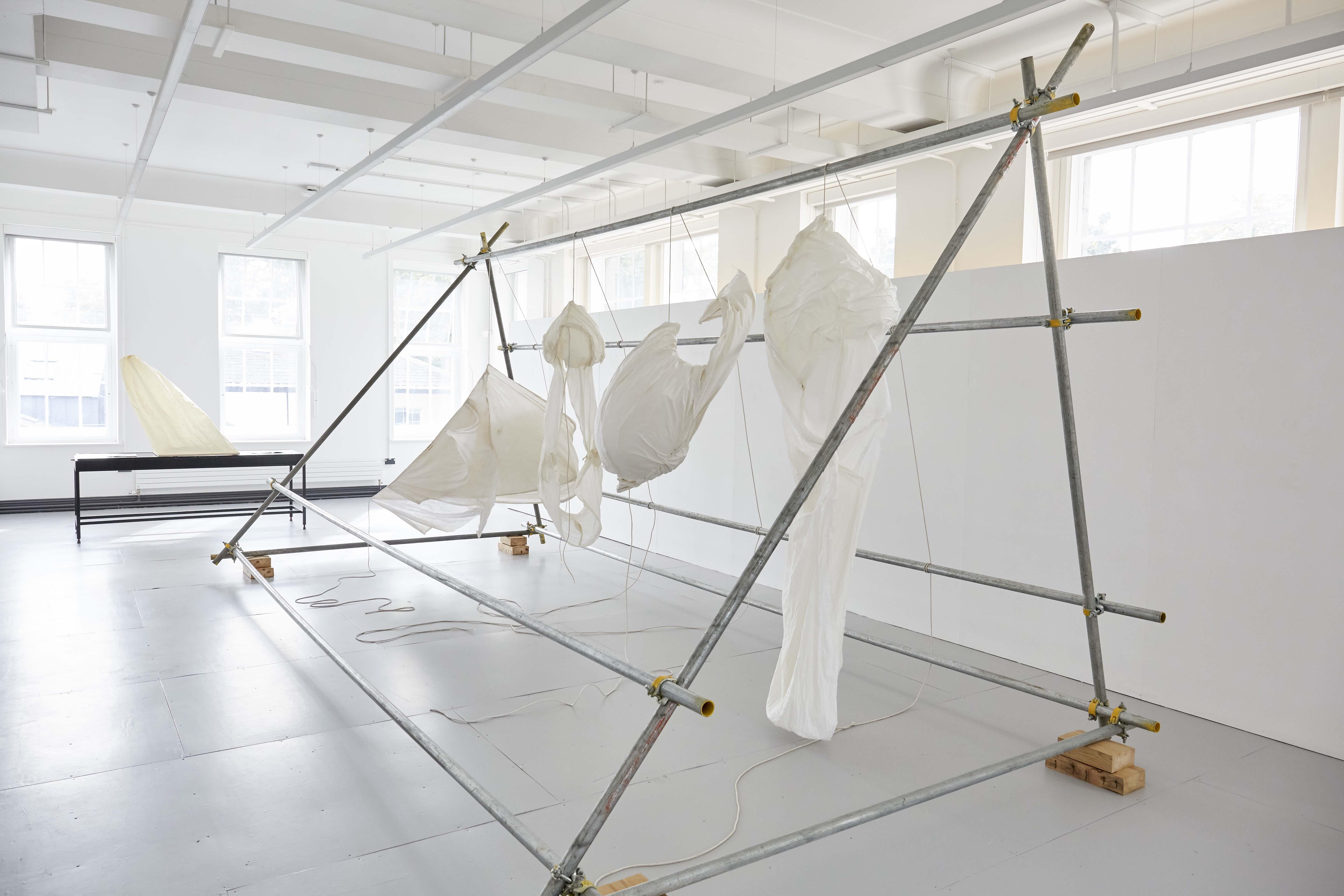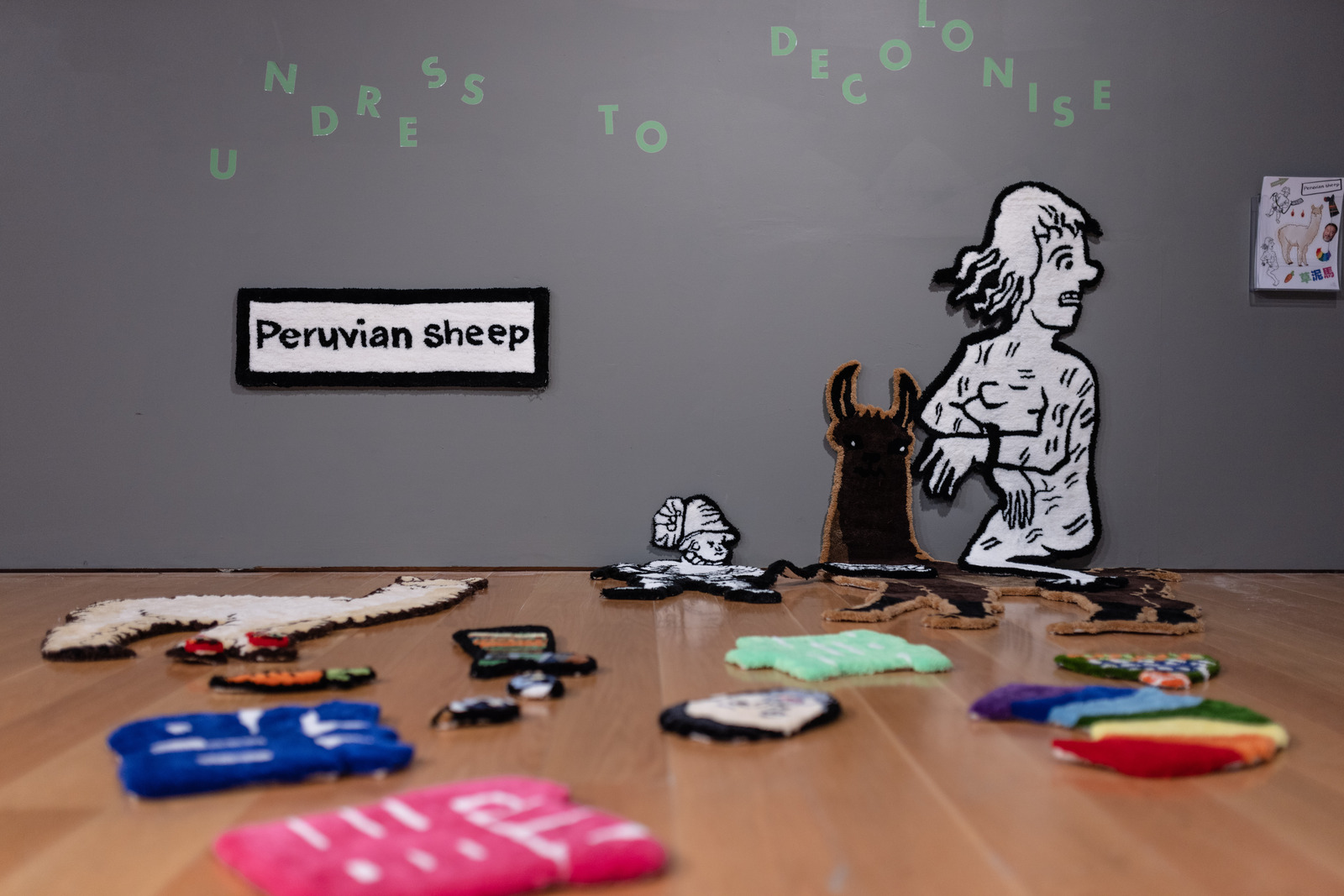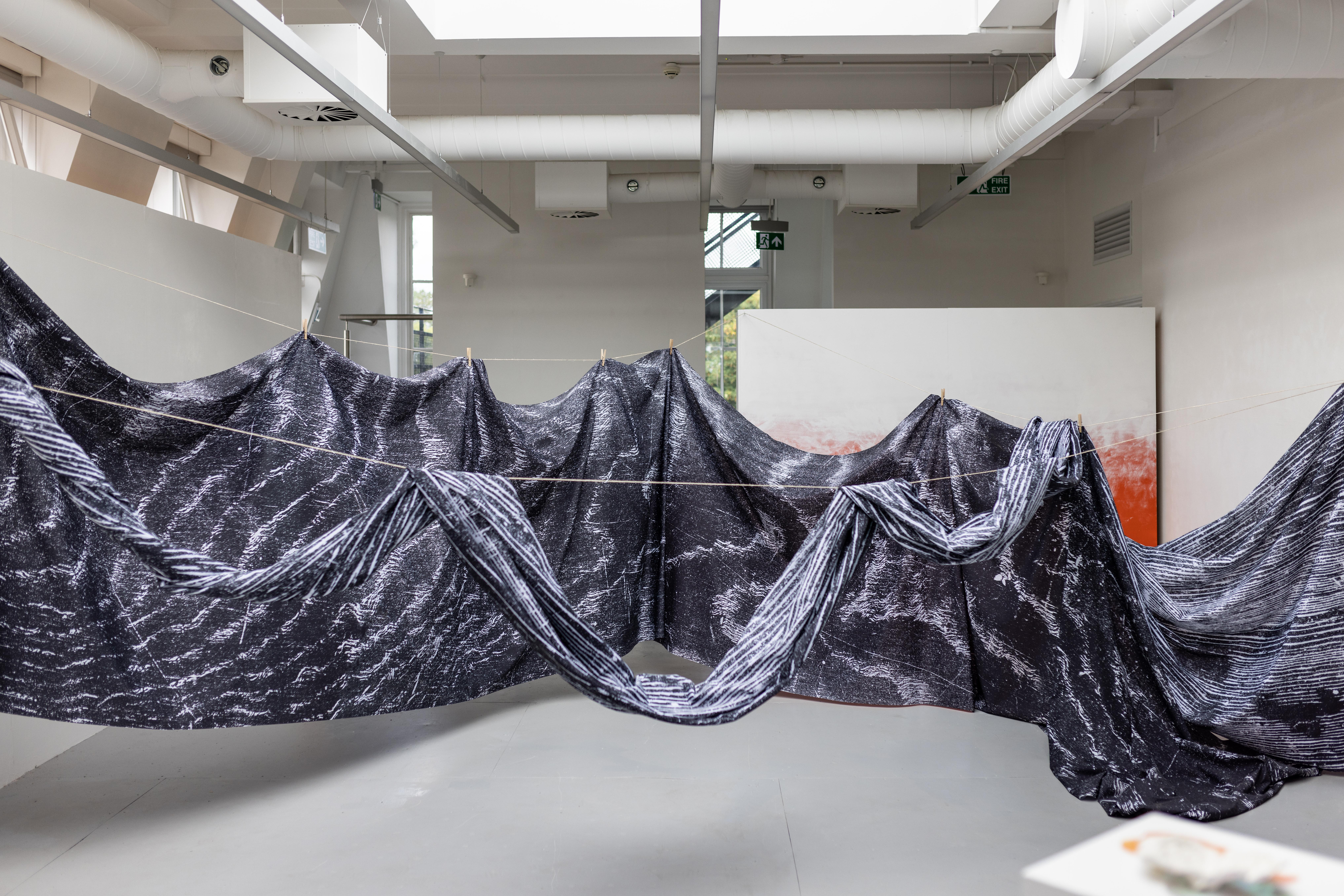- Faculty of Arts, Humanities and Cultures
- School of Fine Art, History of Art and Cultural Studies
- Masters
- Exhibitions and degree show
Student work
Student work
Throughout the year, our Masters students engage in solo and group projects, making use of the School’s dedicated spaces, venues on the University campus and across the city and numerous online resources.
Our Masters students are expected to produce a dissertation, an independent and self-devised research project on a topic of particular interest to the student. See below for previous dissertation topics.
View our event listings for more information on current and previous exhibitions.
Degree show 2024
The show celebrates the work of five graduating students, ranging through all mediums of contemporary practice. Website: fatbaby.leeds.ac.uk
Degree show 2022
Inherent to each graduating MA Fine Art student's work was something hidden, either latent in nature or concealed by materials, conditions, processes or states of being.
Image by Andy Lord.
Image by Andy Lord.
Image by Andy Lord.
Image by Andy Lord.
'West Yorkshire Soco (failure to progress in labour)', 2022. Coal, Canarian Drago tree sapling, Yorkshire wool, circular wooden loom.
Image by Andy Lord.
Image by Andy Lord.
Image by Andy Lord.
Degree show 2021
Graduating artists from the MA Fine Art degree showcase solo and group projects depicting their digital Master's experience and the myriad of ways this has manifested into a physical exhibition.

Audio visual installation.
Image by Jules Lister.

Photograph.
Image by Jules Lister.
Textiles and wood.
Image by Jules Lister.
Mixed media.
Image by Jules Lister.
Mixed media.
Image by Jules Lister.
Mixed media.
Image by Jules Lister.
Inkjet prints.
Image by Jules Lister.
Oil on canvas.
Image by Jules Lister.
Video animation.
Degree show 2019
Graduating artists from MA Fine Art pose the question: what happens between ‘becoming’ and ‘after’?

animals are kind, 'Evolution, Involution, Revolution'
"Evolution, Involution, Revolution is a sound assemblage of field recordings at different times and locations. The recorded materials are kept as original as possible, while multiple tracks are superposed and projected across the space. The choice of sound, the way they are arranged and the layout of the installation as a whole intends to convey a sense of connectedness - the connection between the inside and the outside, me and you, us and other lives on earth, the past and the future."
"This moment more than any other is for us to stop and reflect - Who are we? What is our position in the planet, in the history, in the universe? What are we doing? How will we live? Remember that we are becoming-after."

animals are kind, 'Evolution, Involution, Revolution'
"Evolution, Involution, Revolution is a sound assemblage of field recordings at different times and locations. The recorded materials are kept as original as possible, while multiple tracks are superposed and projected across the space. The choice of sound, the way they are arranged and the layout of the installation as a whole intends to convey a sense of connectedness - the connection between the inside and the outside, me and you, us and other lives on earth, the past and the future."
"This moment more than any other is for us to stop and reflect - Who are we? What is our position in the planet, in the history, in the universe? What are we doing? How will we live? Remember that we are becoming-after."

Lee Warner, 'Untitled'
"The piece on show is a combined response to the research of interpretation, the exhibition space, and the underlying concept of the exhibition. It embodies the personal change of perspective on Fine Art practice and demonstrates the evolution of the artist's creative practice. Unknowns are defined as such in relation to knowledge. The known exists within a system of differences alongside other knowns; an unknown occupies a strange other realm."
"Is it installation, intervention or interruption? Is it a portrait of a discussion or conversation? Is it rags hanging from a bar?...The reading is a question about ambiguity and nature of things in relation to the individual."
Lee Warner, 'Untitled'
"The piece on show is a combined response to the research of interpretation, the exhibition space, and the underlying concept of the exhibition. It embodies the personal change of perspective on Fine Art practice and demonstrates the evolution of the artist's creative practice. Unknowns are defined as such in relation to knowledge. The known exists within a system of differences alongside other knowns; an unknown occupies a strange other realm."
"Is it installation, intervention or interruption? Is it a portrait of a discussion or conversation? Is it rags hanging from a bar?...The reading is a question about ambiguity and nature of things in relation to the individual."
Lee Warner, 'Untitled'
"The piece on show is a combined response to the research of interpretation, the exhibition space, and the underlying concept of the exhibition. It embodies the personal change of perspective on Fine Art practice and demonstrates the evolution of the artist's creative practice. Unknowns are defined as such in relation to knowledge. The known exists within a system of differences alongside other knowns; an unknown occupies a strange other realm."
"Is it installation, intervention or interruption? Is it a portrait of a discussion or conversation? Is it rags hanging from a bar?...The reading is a question about ambiguity and nature of things in relation to the individual."
Oliver Roberts, Perylene Red & Cadmium Deep Hue
"The works exhibited comprise a large canvas and a work on paper painted with a variety of oil mediums including Poppy oil, Galkyd medium and Turpentine. The outcome of the painting on canvas is a sheen and tactility which reflects colour in a manner that is both eye-catching and a nod to the post minimalist painting of the late 20th and early 21st centuries. In opposition to this is a paper-based work, made from the same pigments. The pair compare and contrast in a way which gives them a relational aesthetic that suggests a connection and correlation."
Oliver Roberts, Perylene Red & Cadmium Deep Hue
"The works exhibited comprise a large canvas and a work on paper painted with a variety of oil mediums including Poppy oil, Galkyd medium and Turpentine. The outcome of the painting on canvas is a sheen and tactility which reflects colour in a manner that is both eye-catching and a nod to the post minimalist painting of the late 20th and early 21st centuries. In opposition to this is a paper-based work, made from the same pigments. The pair compare and contrast in a way which gives them a relational aesthetic that suggests a connection and correlation."
Oliver Roberts, MA Fine Art degree show 2019
Lucy Crouch, 'Impermanent Separation'
"The concept of drawing is the subject of Lucy’s work, focusing on the crucial role of materiality within an essential language of drawing. The works exhibited use graphite as both mark-making tool and as a material for the physical structure, allowing the qualities of the material to determine the form of the work. Rather than expressing a line, graphite expands and contracts to expose its own surface."
Lucy Crouch, 'Draw in/ draw out'
"The concept of drawing is the subject of Lucy’s work, focusing on the crucial role of materiality within an essential language of drawing. The works exhibited use graphite as both mark-making tool and as a material for the physical structure, allowing the qualities of the material to determine the form of the work. Rather than expressing a line, graphite expands and contracts to expose its own surface."
Lucy Crouch, 'Slice of Light'
"Lucy’s research stems from her explorative play with materials, and is supported by an active engagement with the intersection of New Materialism and drawing. The drawn gesture is embedded in the spatial objects comprised of graphite, the material itself becoming activated through its density of weight and mark, as well as a delicate gossamer thinness. The sculptural forms sit between muteness and clamour, interacting with the architecture of the space they are sited within."
Celeste Taylor, MA Fine Art degree show 2019
"Celeste works in a variety of media, predominantly textiles and artists books, to explore the complicated relationships between history, landscape and indentity. Her work is rooted in the research of how Neolithic sites inform our ideas of landscape, ancientness, and the natural. Informing this body of work, she has examined how works of fiction refer to Neolithic landscapes, expressing an understanding of these sites beyond what is certain."
Celeste Taylor, 'the sun rises in front of you'
"Celeste works in a variety of media, predominantly textiles and artists books, to explore the complicated relationships between history, landscape and indentity. Her work is rooted in the research of how Neolithic sites inform our ideas of landscape, ancientness, and the natural. Informing this body of work, she has examined how works of fiction refer to Neolithic landscapes, expressing an understanding of these sites beyond what is certain."
Celeste Taylor, 'Contradictions in Ancient Spaces'
"Undertaking many site visits across Britain, Celeste's work explores the tension between inside and outside space created by Neolithic ruins as they exist as both part of the natural landscape and as a human creation. Neolithic sites also create tension through their simultaneous significance and perpetual ambiguity. They challenge the notion that meaning is solid and create paradoxical places where fantasies of origin can play out. They have had a variety of meanings throughout human history, from the home of monsters to symbols of kingship, which contribute to their multifaceted meaning today."
Celeste Taylor, 'Fictions Chorography: HOTB'
"Celeste works in a variety of media, predominantly textiles and artists books, to explore the complicated relationships between history, landscape and indentity. Her work is rooted in the research of how Neolithic sites inform our ideas of landscape, ancientness, and the natural. Informing this body of work, she has examined how works of fiction refer to Neolithic landscapes, expressing an understanding of these sites beyond what is certain."
John Ledger, prop from 'Wall, i' film
"For the MA degree show John has been working on the extensive multi-disciplinary and collaborative film project 'Wall, i'. An autoethnographical exorcism, for a generation who's formative years were 30 years ago as the Berlin wall fell, 'Wall-i' toys with many of the themes in Pink Floyd's The Wall (on its 40th anniversary), for the 'millennial' generation reared on promises of a future where one could be whatever they wanted to be.
"Wall-i' is about a character who becomes trapped in himself as such promises start to crumble; unable to connect, he falls into mental ill-health, spells of addiction, bitter resent and hatred."
John Ledger, 'Wall, i'
"For the MA degree show John has been working on the extensive multi-disciplinary and collaborative film project 'Wall, i'. An autoethnographical exorcism, for a generation who's formative years were 30 years ago as the Berlin wall fell, 'Wall-i' toys with many of the themes in Pink Floyd's The Wall (on its 40th anniversary), for the 'millennial' generation reared on promises of a future where one could be whatever they wanted to be.
"Wall-i' is about a character who becomes trapped in himself as such promises start to crumble; unable to connect, he falls into mental ill-health, spells of addiction, bitter resent and hatred."
John Ledger, prop from 'Wall, i' film
"For the MA degree show John has been working on the extensive multi-disciplinary and collaborative film project 'Wall, i'. An autoethnographical exorcism, for a generation who's formative years were 30 years ago as the Berlin wall fell, 'Wall-i' toys with many of the themes in Pink Floyd's The Wall (on its 40th anniversary), for the 'millennial' generation reared on promises of a future where one could be whatever they wanted to be.
"Wall-i' is about a character who becomes trapped in himself as such promises start to crumble; unable to connect, he falls into mental ill-health, spells of addiction, bitter resent and hatred."
Michiko Yamamoto, 'Slow Slaughters', mixed media, 2019
"Personal tragedy and natural disaster can often be slow, quiet, and invisible, much like climate change; but powerful beauty can be found in poignant moments."
"My installation reflects my father's dying and the fragility of life and nature. In the initial stages of creation, I was trying to concentrate on the concept of climate change, attempting to separate the individual distress from the initial idea of environmental art. However, because my father's terminal illness was so dominating, I began to make clay sketches of responding to the experience combining my thoughts about him with images of our disappearing nature. By mixing images, such as my father's skinny hand and a dead branch, the outcomes became harmonised and made me realise that we are all integral elements of nature.
All the shapes are made from my thoughts that used to exist in a safe place in my head. Some objects may seem familiar - but not quite. The lack of colour, weight, details and definitions suggest a delicate yet controlled balance, reflecting the condition and fragility of the nature around us. "
Michiko Yamamoto, 'Slow Slaughters (rinne)', mixed media, 2019
Michiko Yamamoto, MA Fine Art degree show 2019
MA Fine Art exhibitions throughout the year
Other exhibitions
Every year, students on from our Art Gallery and Museum Studies, Arts Management and Heritage Studies and Curating Science and Technology courses curate group exhibitions.
View our event listings for more information on current and previous exhibitions.
Here are some examples of the online and physical exhibitions produced by our Masters students:
-
Small Objects, Big Protest: Everyday objects infused with messages of protest (online)
-
Dissecting Consent: Exploring the Use of Human Bodies in Medicine Through Time (online)
-
Sanctuary: A Digital Green Space (online)
-
The Fragile Deep (online)
-
Strings Attached: The Ties That Bind Yorkshire to its Global History (online)
-
Breaking the Binary (online)
-
First Waves: Exploring the impact of the race relations acts in the UK
-
The Many Forms of English: 55 Years of Language Centre Teaching
Student dissertations
Here are some examples of the dissertation titles submitted by our Masters students.
MA Art Gallery and Museum Studies
-
A Survey of the Epistemological Turn in Contemporary Decolonisation Discourse and Practice in Museums in the UK: Pitt Rivers, A Case Study
-
Navigating Taonga in Foreign Places: A Case Study of Hinemihi o te Ao Tawhito in Clandon Park
-
The Statue of Edward Colston: 21st century interventions and their impact on Collective Memory, Urban Space and Public Engagement
-
Engaging audiences from a social distance: A case study into the Natural History Museum and the digital tools used during the COVID-19 pandemic
-
What elements constitute an online exhibition? Two case studies in the Taiwanese context
-
Interrogating the urban palimpsest of York through the city and the York Castle Museum
-
Exhibiting beyond the binary: trans-formative practice and the limits of the museum
-
Nation, Representation, and ‘Eminence’: How the National Portrait Gallery justifies elites through the creation of a meritocratic narrative
-
She’s Got Game: Femininity and Feminism in the Preservation and Collection of Videogames in Archives and Museums








